|
|
Barcaldine

|
|
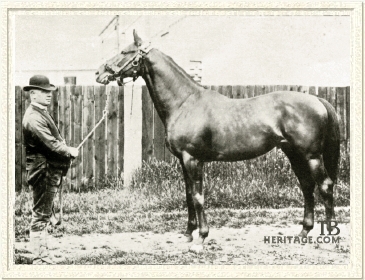 |
|
|
Barcaldine was an unbeaten racehorse whose career was occluded by the actions of his owner, and who was not, many said, "ever really extended." He got two classic winners and a number of useful runners not quite up to classic standarDs, some of them great stayers, and through his daughters had an influence on breeding in the U.S., Australia and South America. His son, Marco, continued the Godolphin Arabian sire line.
His sire, Solon (1861), bred in Ireland by Christopher St. George at Tyrone House, County Galway, was one of the less impressive sons of the English Triple Crown winner, West Australian. Solon was a big growthy colt, not started until age three. He was a roarer, but nonetheless, won nine of his seventeen races, all but one of them in Ireland. Retired to stud in Ireland, he was sold at the Curragh for 55 guineas just before Barcaldine embarked on his great juvenile year. In addition to Barcaldine he got Arbitrator (1874), who at age three won the Great Lancashire Handicap and the Liverpool Autumn Cup; Arbitrator later sired Kilwarlin (1884), who crossed the channel to win the Doncaster St. Leger, and from whom Ogden (1894), and his sire, the good American race horse The Finn (1912) descended in tail-male. Through Arbitrator, Solon is also seen in the pedigree of the beloved runner Brown Jack. Solon also got some good fillies, including the Irish Derby winners Maid of Athens (1868) and Slyph (1880).
Solon also sired a number of steeplechasers, among them Irish Grand National winner, Controller, and Grand Steeple-Chase de Paris winner, Whisper Low, and Mary Hyland, who won over fences and later was dam of Too Good, another Grand Steeple-Chase de Paris winner.
Barcaldine, a bay, was the third foal of Ballyroe (1872, Family 23), a daughter of Belladrum, who had been bred by George Low, a Scotchman who rented a farm on the Duke of Leinster's estate at Birtown, County Kildare. Ballyroe ran four times at the age of two only, placing second in a field of four in one of those races, over five furlongs at Dublin. Her sire had won two good races at age two, the New Stakes at Ascot and Epsom's Woodcote Stakes; he was a roarer. Ballyroe's dam, Bon Accord (1867, by Adventurer) was out of Solon's dam, making Barcaldine, 2 x 3 to the 1850 daughter of Birdcatcher, sometimes known as "Darling's dam."
Baracaldine was unprepossessing as a yearling, but by the time he was ready to start, he had filled out, and eventually he reached 16.1 hands in height, with "a beautiful frame." Opinions varied on his temperament -- trainer George Lambton said he noticed Barcaldine youngsters all had a temper, but his first trainer, Connolly, said he "had no semblance of vice or temper." Barcaldine's last owner while racing, Robert Peck, who trained the great Doncaster, later said of Barcaldine "...the only two horses that ever looked like him were Doncaster when he won the Ascot Cup and the Alexander Plate at five years old and Verneuil, when he won at Ascot. Those two horses were....as big as bullocks and as hard as nails, with a beautiful bloom on their coats...no course was too long for them, and no weight too heavy for them to carry."
A trial held at Curragh View before his first race showed him to be an exceptional youngster; he ran over "a very severe 6 furlongs" against the three year old Belfast Handicap winner, Berengaria (a sister to Barcaldine's dam, Ballyroe), giving her 9 pounds, and beat her easily. In his first race, the Railway Stakes at the Curragh, in September of his two year old year, he won in a canter, and then went on to win the National Produce Stakes by four lengths, carrying 126 pounds, the Beresford Stakes of one mile (133 pounds), and Paget Stakes of six furlongs, carrying 130 pounds; these three races were held on successive days. That was the end of his two year old season.
Low told his trainer, Connolly, that he planned to run Barcaldine in the more important English handicaps, specifically the Manchester Cup and the Northumberland Plate the following year, and Barcaldine was schooled accordingly, but Low decided to run him in the 1-1/2 mile Baldoyle Derby in May, giving Connolly 19 days notice. He won this race, half-fit, by a length. In some kind of complicated plan for winning by betting on Barcaldine, Low decided to strike him from the Manchester Cup in June, instead running him in for three straight days in late June in three Queen's Plates at the Curragh, one at two miles, and two at three miles -- Barcaldine was three years old. He won the first two, and walked-over for the third. He was scheduled to run in the Northumberland Plate, but a muddled telegram from Low to a steward of the Jockey Club regarding what appeared to be some sort of shady offer regarding striking Barcaldine, or, alternatively changing the odds of 7:2 on Barcaldine in the race caused Low to be warned off, and Barcaldine did not run and was shortly thereafter offered for sale. He remained in Connolly's yard, although he was told the horse had been sold privately to a "gentleman from abroad," and was paid by an agent.
The effects of his owner's actions dragged on into his four year old year. He was entered for the Cesarewitch of 1882, but struck out. Taken to Newmarket to prepare for the Cambridgeshire with a 119 pound handicap, Connolly was called before the Jockey Club stewards investigating Barcaldine's true ownership. The stewards decided the sale was not bonafide, and Barcadline was struck from the Cambridgeshire as well. So ended his unraced four year old season.
He was sold truly and without question at the end of 1882 to trainer Robert Peck, out of condition. Peck brought him along slowly, with mashes and walking exercise to the end of the year, and Barcaldine began training again for the 1883 season. His debut that year was an easy win over the very good handicapper Tristan (winner of the Ascot Gold Cup and the Gold Vase, and twice winner of the Hardwicke Stakes, and later sire of Canterbury Pilgrim) in the 1-1/2 mile Westminster Cup, a weight-for-age race at Kempton. That was followed by a win of the 1-1/2 mile Epsom Stakes, carrying 130 pounds, another in the 3 mile Orange Cup at Ascot, and finally the Northumberland Plate under 136 pounds, winning by two lengths over a field of nine. History records three different versions of how Barcaldine came to the Northumberland -- lame or sound-- and afterwards, and when he went lame, exactly, but the fact is, although he was rested in hopes of competing in the Cambridgeshire in the fall, he never ran in a race after the Northumberland, and was retired to stud.
Barcaldine in the Stud
Barcaldine was sold to Lady Stamford for £8,000, and he was put in her stud at Park Paddocks, Newmarket with a fee of 50 guineas, where he stood until his death nine years later from a liver abcess. He got winners of 305 races in England.
Barcaldine was not a big success as a stallion, but he got a steady number of winners. He got two really good runners, Mimi and Marco, the dual-classic winner Sir Visto, and some stayers that won good races. But he still proved to be influential through his sons and daughters, in America, England, France, South America, and Australia. Marco continued the sire line in England, and had a big impact on steeplechase breeding, as well. Barcaldine's daughter Mauvorneen, sent to the U.S., bred the champion sprinter Voter and Maid of Erin, dam of the speedy Celt. Another Barcaldine daughter became the dam of the great classic winner in France, Perth, later sire of Alcantara II. Another daughter was the dam of Oran in Argentina, he the sire of the celebrated Old Boy. Barcaldine's son, Wolf's Crag, got Linacre, twice leading sire in Australia, and a Barcaldine daughter, Barley produced Malster, the five-time leading sire there.
|
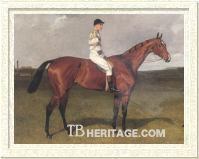
Mimi won the One Thousand Guineas and the Oaks
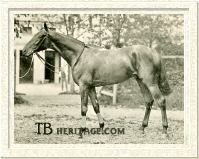
Sir Visto won the Derby and St. Leger
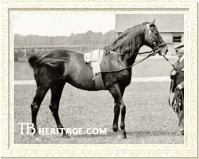
Ascot Gold Cup winner Morion was a useful sire
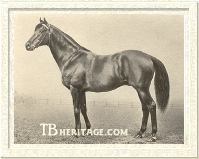
Wolf's Crag got Linacre, a leading sire in Australia
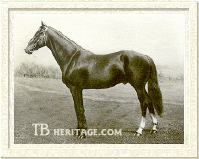
Marco carried on the sire line
|
|
MIMI (1888, out of a Lord Lyon Mare), bred at Sledmere Stud in Yorkshire, won the One Thousand Guineas, the Oaks and the Newmarket Stakes and a total of £14,342; she was later dam of Cesarewitch winner Mintagon and of the good handicapper St. Maclou.
Barcaldine's other classic winner was SIR VISTO, winner of the Derby and the St. Leger, considered a lucky horse in a generation of modest runners. He was out of the Macaroni mare, Vista, and bred by Lord Rosebery in 1892. He won one race as a juvenile, the Imperial Produce Stakes at Kempton, after having failed to place in his only other outing, Epsom's Woodcote Stakes. He did not place in his first race at age three, the Two Thousand Guineas, nor in the Newmarket Stakes, which was won by The Owl. He came in 3/-4 of a length in front of Curzon, a gelding, and Kirkconnell in the Derby, and in his next race, the Princess of Wales's Stakes at Newmarket, was unplaced, conceding the winner, Le Var, 16 pounds. He then won the St. Leger by 3/4 of a length, beating Telescope, and ran unplaced in the Jockey Club Stakes. At age four he ran second to Persimmon in the Jockey Club Stakes, and third in Newmarket's Champion Stakes, and was unplaced three times, after which he was retired to Rosebery's Mentmore Stud.
SIR VISTO was not successful as a sire, but he did get Chelys (1901, from Chelandry), a modest handicapper that became the dam of the good stayer Chili II. He was shot in July of 1914, after having been pensioned at the Durdans, Epsom, where he was buried.
Some of Barcaldine's other winners included Lincolnshire Handicap winners WOLF'S CRAG and PRINCE BARCALDINE; THE RUSH, who won the Liverpool Autumn and Chester Cups; MORION (1887, out of Chaplet, by Beadsman), winner of the Ascot Gold Cup, Royal Hunt Cup and 9 other races; Derby Cup winner DUMBARTON; and MARCO, who won the Cambridgeshire Handicap stakes.
MARCO was considered the best of his generation at age three, despite his not contesting the classics. He was a game winner and good weight carrier. In the stud he got a number of winners, including Two Thousand Guineas winner Neil Gow, Omar Khayyam, the first foreign-bred horse to win the Kentucky Derby, and Sprig, a winner of the Grand National Steeplechase. His daughter, Casetta, was dam of Cottage, sire of a number of top steeplechasers, including three Grand National winners. Horses such as My Babu, Klarion, Bustino, and Kelso trace to Marco's daughters in tail-female descent. Marco's son, Marcovil, a modest runner, continued the sire line by getting the great racehorse and sire, Hurry On.
Barcaldine's son, WINKFIELD (1885), a brother to MORION, won three modest races, but in the stud got Doncaster and Ascot Cups winner Bachelor's Button, and Cambridgeshire Stakes and Doncaster Cup winner Winkfield's Pride, who sired some very good winners in France. Another son, GOODFELLOW (1887), got Doncaster Cup winner Chaleureux. Barcaldine son ESPOIR (1889) won the German Derby and the Hungarian St. Leger, among other races. Wolf's Crag's best son, Linacre, was a good winner in the U.K. and was sold to Australia, where he was twice leading sire.
Of Barcaldine's good daughters, some were: PRIMROSE DAME, dam of the great French racehorse Perth (French Derby, French St. Leger, Grand Prix de Paris and more), and MYRTLEDINE, dam of MacDonald II (top winner in Germany and France and sire).
Barcaldine's daughter MAVOURNEEN (1888, from Gaydene by Albert Victor) won the Hopeful and Beaufort Stakes in England. She was taken, with her chestnut 1894 colt, Voter (by Friar's Balsam) at side, to the U.S. by Foxhall Keene, and installed as a broodmare at Castleton Farm, owned by Keene's father, James R. Keene. She was in foal to Amphion.
|
Voter turned out to be a high-class sprinter with a bad temper, although he did win at a mile occasionally. He ran until the age of seven, including a disasterous year in England, winning 26 of his 49 starts, unplaced ten times. His best win was probably the one mile Test Stakes at Brighton Beach, in which he broke the track record in 1:38. He stood at stud at Castleton until Keene's death in 1913, after which, purchased by M.J. Sanford for $14,000, he was sent to France; In 1919 he was sold, and was placed in the Bel Sito Stud in Girone, dying the next year. His largest crop was 18 foals, in 1913. His best was his son Ballot, a good winner and near the top of the leading sire's list in seven consecutive years. Voter also got Electioneer, The Manager, a top three-year old, and through son Runnymede, was grandsire of the great Morvich. Voter's daughter, Curiosity, produced Novelty, the champion two year old in the U.S., a winner in Canada, and then France, and in Brazil was a multiple time leading sire and sire of broodmares. Curiosity's daughter, Wonder, became the dam of the U.S. champion juvenile colt John P. Grier and of the good producer Miss Whisk.
Mavourneen's foal by Amphion was a filly, Maid of Erin, who became the dam of Celt (1905, by Commando), who ran only four times at ages 2 and 3, winning three, and placing once to stablemate Colin in the 7 furlong Flatbush Stakes for juveniles at Coney Island. His wins were the Junior Champion at Brooklyn, a 9 furlong handicap in which he beat near-relative Jack Atkin, and the 1-1/4 mile Brooklyn Handicap, easily beating Fair Play and King James, to whom he was giving weight. At the Keene dispersal he was purchased by A.B. Hancock for his Ellerslie Stud, but this was the period in America when racing was largely shut down, and in New York there were no races between 1910 and 1913. Hancock, like many others, were practically giving away mares and foals. With limited opportunities, Celt became the sire of precocious juveniles; he died in 1919, age 14, and posthumously was a leading sire in the U.S. in 1921, with six stakes winners. He is best known today as sire of Marguerite, the dam of Triple Crown winner Gallant Fox, and he is seen in pedigrees through that colt, through Marguerite's other sons, Fighting Fox and juvenile champion in England Foxbrough, and through Marguerite's daughters.
Barcaldine's daughter IRISH JEWEL, sent to Argentina, produced Oran, winner of a number of races in Argentina, including the Premio General Belgrano and gained everlasting fame in South America by getting Old Boy, a great runner and highly influential sire in Chile. A Barcaldine son sent to Argentina, SARGENTO, had four good daughters there, one of them, Neva, became the dam of the first mare to win the Triple Crown in in Chile.
Barcaldine's daughter BONNY ROSETTE (1887) produced a good runner in Undecided, and then was shipped, in foal, to Australia, where she produced seven winners, the best of them Mountain King, winner of the AJC and VRC Derbys and St. Leger and many weight-for-age races. Her tail-female descendants include Kaoru Star (1965, top sire in Australia). Another Australian horse, Maltster (1897), who won the AJC Derby and other races and was later five time leading sire in Australia, was out of BARLEY (1888). Barley also produced Harvest Lass (1891), a great producer in Australia.
Many other Barcaldine daughters produced or were tail-female ancestresses of winners in countries throughout Europe, Australasia, and South America, where staying and weight-carrying abilities were prized. Some of these were the dams of Gamechick (Dewhurst, Champagne and National Breeder's Produce Satkes); Steward's Cup winner O'Donovan Rossa; St. James Palace Stakes winner Millenium; Austrian Derby and Austriapreis winner Llubar; and Nagroda Rulera (Poland) winner Trafalgar.
--Patricia Erigero
|
|
|
|

